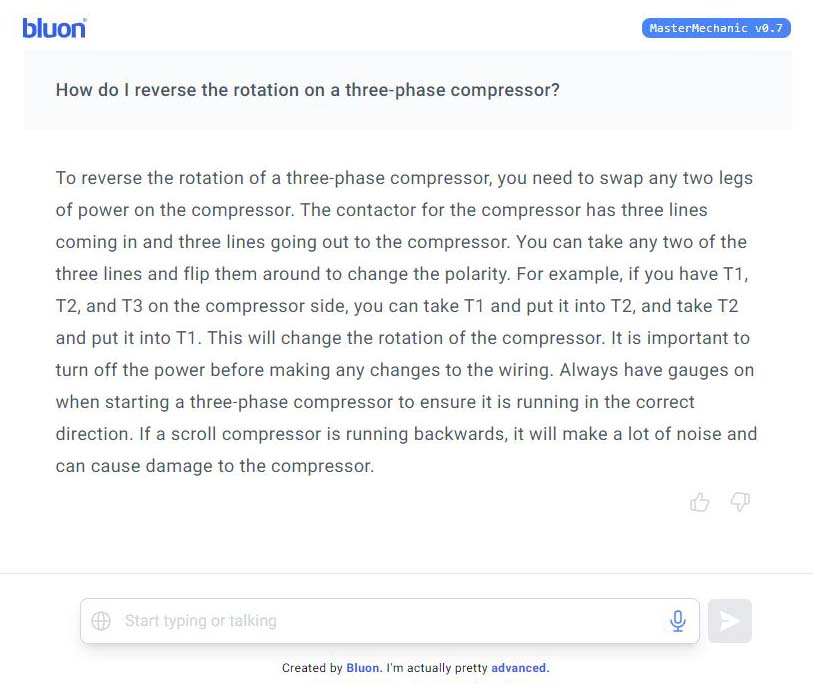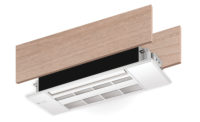The year is 2025, and a twenty-something HVAC technician is in the basement on a service call. She’s new on the job; it’s heating season, it’s one of her first service calls on her own, and she’s running into an issue with the furnace. Stumped, she pulls out her iPhone — but not to call her service manager. Instead, she opens an app.
“What causes a roll out switch error on a 90+ gas furnace?” she says.
The app spits out:
A roll out switch error on a 90+ gas furnace can be caused by several factors. Some possible causes include:
- Cracked heat exchanger: A cracked heat exchanger can cause the roll out switch to trip. This can happen because the cracked heat exchanger allows the burner's gas to back up in the burner compartment, leading to a roll out of the flame.
- Soot inside the heat exchanger: If there is soot or other debris inside the heat exchanger, it can block the flow of gas and cause it to back up. This can also lead to a roll out switch error.
- Gas pressure issues: Excessive gas pressure can cause excessive heat, which can cause the roll out switch to trip. Similarly, low gas pressure can cause delayed ignition, which can also trigger a roll out switch error.
- Dirty burners: Dirty burners can cause delayed ignition, which can also result in a roll out switch error.
- Flame rollout: A flame rollout can occur when the flame does not properly ignite or burn within the designated area. This can cause the flame to escape beyond the intended area, which triggers the roll out switch.
Not your typical ChatGPT response, eh? That’s because this isn’t ChatGPT, skimming generic internet content in an attempt to match a technician’s detail-oriented query. Quite the reverse, this AI has been trained on 50,000 HVAC tech support calls from master HVAC mechanics. And it answers HVAC troubleshooting questions with 96% accuracy.

AI MENTOR: The MasterMechanic app was trained on 50,000 HVAC tech support calls and responds to questions using natural language. (Staff image)
This may seem a little futuristic, but the first generative AI tools designed specifically for HVAC — like MasterMechanic, as well as Interplay's SAM, launched in June — are actually available now. Created by software company Bluon Inc., MasterMechanic launched in late August, less than a year after ChatGPT came out. It’s designed to give HVAC technicians step-by-step answers to specific, complex problems in language that is easy to follow and specific to the issue at hand.
Adam Curry, senior vice president at Bluon, believes this is AI’s future: domain-specific training, or feeding specific information to the AI so that it becomes highly skilled in spitting out answers based on that set of content.
“This, I think, is going to be the next phase of AI,” Curry said. “The problem is that when you're building an AI like ChatGPT, you're training it on generic content from the internet, blogs, Wikipedia, just stuff that exists out there. While it's good for general information, it's really bad for specific information, like what a technician would need to know. And that's essentially what the thinking was behind MasterMechanic and the Bluon app. We have, like, the best data source in the HVAC industry. And so one way that we can leverage that is by using it for training the AI.”
Peter Capuciati is chairman and CEO at Bluon. Building the tool took several phases and four years’ worth of troubleshooting calls, he said.
“We had 50,000 tech support calls that we've been transcribing for years, and we were able to take all that information and produce a giant LLM [large language model] that we could train the AI on to answer specific questions,” Capuciati said.
“We were pretty shocked, actually, at how capable this system was, and how accurate it was” upon developing the initial proof of concept, Curry added. “So we knew that we were onto something.”
A subsequent version was sent to Bluon’s HVAC expert, who was tasked with evaluating and testing it to see if it gave correct answers and was comprehensive enough.
“He went down a research hole for a couple of months and devised a 400-point questionnaire that covers everything from basic residential stuff all the way to complex industrial equipment, and what questions somebody would ask,” Curry said. “Then he manually put in all those questions, went through every response, and tweaked it.”
The first time it got graded, it got an 82% — a B+. Since then, it’s been optimized so that it answers with a 96% accuracy, he said.
“So, when a technician asks a question, they can have a high degree of confidence it's going to be very accurate,” Capuciati said. “What's really cool about it is it works for commercial; about 35% of our calls are commercial, which are a whole different level of complexity, and the AI really shines in that commercial world, where you have a very specific question and a very specific issue. It pulls out a very, you know, do the following steps to solve the problem in a methodical way. It's all based on that data we've accumulated over the last three or four years.”
The beta version of MasterMechanic is available publicly to the entire industry at bluon.ai through October 31, 2023. Its creators hope HVAC technicians take the opportunity to give it a whirl.
“It’s really meant to get beat up by the industry, see what people think, and then it will be free for Bluon members on the on the app after that,” Capuciati said.
Since the program is in beta mode, user data hasn’t yet been analyzed, but Capuciati anticipates MasterMechanic will be popular among Millennial and Gen Z technicians because it caters to the younger generations’ learning style.
“Historically, Gen X and boomers learn by memorization and training,” he said. “That’s not the way Millennials and Gen Zs learn — they learn by indexing and resourcing, and I think the industry has not figured it out yet. HVAC is still caught in the ‘90s. And so doing this — to enable this new set of technicians that come in and have access to tools and training that will let them learn their way — I think is a really big deal, because that has to get solved, or this skill gap is going to get worse and worse.”
If this proves true, AI tools such as MasterMechanic could make a big dent in another aspect of the labor issue: the wisdom lost as older, highly skilled workers leave the industry.
“You have a 60-year-old tech who knows everything, and he retires — it's gone, and there's no way to get it back,” Capuciati said. “We’ve been talking about it for like five years — how do you capture the information in these guys’ heads? This massive database of tech support calls is exactly that; it’s their wisdom, and now we're able to share it, with this technology, in a way that’s really, really cool. It allows for this generational transfer of knowledge without the tech having to sit down and write it all out.”
Bluon’s tech support team is continuously feeding the system new information, he added, so it stays current on new technology and new equipment.
Another benefit the AI app offers contractors is allowing tech support to be scaled.
“Right now, if you call any OEM tech support, you're waiting for two hours minimum right before you get to a human,” Capuciati said. “So No. 1, it's having actionable, real-time information to techs in the field who, more and more and more, need help, because the average skill set of a tech has gone down dramatically in the last 10 years.”
The other side of the coin, he said, is training and real-time support for newer techs who would otherwise be calling their service manager on the regular.
“If you talk to any service manager, 30-40% of their day is taken by answering relatively easy questions that they just have to deal with because, again, back to the labor shortage,” Capuciati said. “It’s a huge time-saver in a contractor organization and allows tech support in a way that it cannot be done currently, because there's just not enough master mechanics out there to answer the questions that are coming in. [The app] is a scaled mentor. Now every new tech can have a mentor they can lean on, and they don't feel stupid for calling the service manager.”








